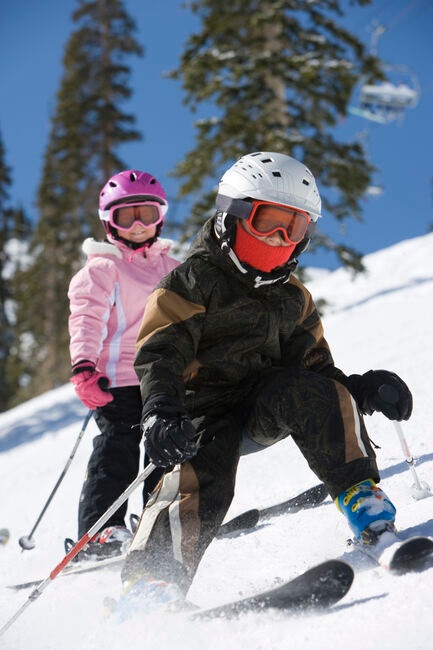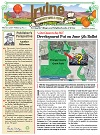 During the winter season, families here in Irvine enjoy participating in a number of sports at nearby mountain resorts. Recently, I sat down with Chris Koutures, MD — a pediatric sports medicine specialist — to discuss tips for keeping kids safe during winter sports activities.
During the winter season, families here in Irvine enjoy participating in a number of sports at nearby mountain resorts. Recently, I sat down with Chris Koutures, MD — a pediatric sports medicine specialist — to discuss tips for keeping kids safe during winter sports activities.
Here’s what Dr. Koutures had to say:
The Definition of Extreme Winter Sports
Winter extreme sports include skiing, snowboarding and ski jumping. They are considered extreme sports because participation often includes extremes of speed, landing from heights, and navigating both natural and created obstacles.
Why Helmets are So Important
Personal experience backed by multiple studies prove that helmets can prevent injury. Every time someone gets on a bike, board or on skis, there should be a helmet on their head. A helmet hanging off the handlebars or kept in the garage is doing absolutely no good. Helmets may not look cool, but a shaved head and scars from an accident look much less cool. To be fully accurate, there are some limitations to helmets. No helmet is 100% protective — they are designed more to reduce skull fractures than concussions. Wearing a helmet does not give you license to be more daring.
Snow sports are leading causes of recreational sports-related head injuries. For snow sports, such as skiing or snowboarding, one study found that helmets decreased the risk of head injury by 35% with no increases in the risk of neck injury.
For more information on the use of helmets, I encourage parents to read the American Academy of Pediatrics (AAP) Policy Statement regarding the importance of helmet use in preventing head injuries. For those who want to dig a little deeper, you can read the Technical Report from AAP.
Selecting the Right Helmet
Since kids are on their bikes all year and enjoy escaping to our local mountains for snowboarding and skiing at this time of the year, parents often ask if their children need special helmets for each activity.
Here are the basic rules for ensuring your child is wearing a properly-fitted helmet:
1. The helmet should sit level and cover the forehead.
2. The strap adjusters should be right under the ears and straps should lie flat against the head.
3. Straps should not hang loose, curl out, or be twisted.
4. Test for proper tightness by being able to put only one finger between the straps and chin.
5. If the helmet can be rocked from side to side, tighten the straps.
6. The helmet should rock slightly forward and backward.
7. Tighten straps if the helmet can be moved up off the forehead or down near the eyebrows.
8. Although add-on stickers and paint can personalize the helmet, they often void helmet warranties.
9. Only purchase helmets with CPSC, ASTM, or Snell stickers certifying safety standards.
10. Multi-sport helmets should carry stickers certifying each sport for which they are approved. (Look for these stickers on the helmet. Do not trust sales information or pictures on the box.)
Other Protective Equipment (Including Wrist Guards and Elbow Pads)
Many younger athletes don’t like wearing pads because “they get in the way, get too hot, or don’t look good.” But, these “uncool” pads work quite well in preventing broken bones, sprains, and road rash from falls or missed stunts.
In fact, wrist guards can greatly reduce the risk of forearm fractures due to falls. Most people would prefer wearing protective pads and guards to wearing a plaster cast for 4-8 weeks.
Other Tips for Preventing Sports Injuries
1. Always know where you are going and be honest with your limits. A common recipe for disaster is to barrel down an unknown trail unaware of obstacles or drop-offs that lie ahead.
2. Take time to preview the course or to ride the pipe a few times at a slow speed before trying tricks at full throttle. This can increase confidence and lower risks of unanticipated falls.
3. Be aware of obstacles (rocks, trees, stairs, cars, and people) that might get in your way.
4. Always look ahead 20-30 yards to anticipate potential dangers and to give yourself time to make adjustments.
5. Be aware of your own skill level and do not allow yourself to be pressured by friends or your ego.
6. If you do not feel comfortable riding the black diamond snowboarding run, do not do it.
7. Have fun and build your skills at a run better suited for your abilities.
8. Fatigue is also a major factor in injuries. That one last run at the end of a long day often ends up truly becoming the last one. Stop at the first signs of fatigue before judgment, endurance, and muscle strength become too low to prevent serious injuries.
 Chris Koutures, MD provides pediatric and sports medicine specialty care at ActiveKidMD in Anaheim Hills. A proud graduate of Irvine High (1986), he is the team physician for the USA Volleyball Men’s and Women’s Indoor National/Olympic Teams; US Figure Skating (many who train at the Great Park); Cal State Fullerton Athletics; and the Chapman University Department of Dance.
Chris Koutures, MD provides pediatric and sports medicine specialty care at ActiveKidMD in Anaheim Hills. A proud graduate of Irvine High (1986), he is the team physician for the USA Volleyball Men’s and Women’s Indoor National/Olympic Teams; US Figure Skating (many who train at the Great Park); Cal State Fullerton Athletics; and the Chapman University Department of Dance.
Dr. Koutures and his associate Dr. Ashika Sharma pride themselves on providing individualized and comprehensive team-based care to patients and families.
- Keeping Your Family Safe This Pool Season - June 26, 2024
- Keeping Kids Safe On & Off the Baseball Field - May 31, 2024
- Are Electric Bikes (E-Bikes) Safe? - March 7, 2024



